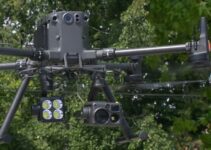Technology that police departments use to detect gunshots is under fire over accusations that it confuses gunshots with other noises, like slamming doors — claims the technology’s manufacturer strongly disputes.
Why it matters: When these devices falsely identify a gunshot, critics argue, police officers can end up rushing to a perfectly peaceful area on unnecessarily high alert, creating a risk of violent interactions out of thin air.
Driving the news: The police reform group Campaign Zero is launching a campaign Thursday to try to convince cities to stop using ShotSpotter as communities struggle with rising gun violence.
- Campaign Zero tells Axios its “Cancel ShotSpotter” effort comes after the group conducted a year-long study of the technology in dozens of cities, which often pay millions of dollars to use the service.
- The group says ShotSpotter has not been proven to reduce serious violent crime, and that it increases the number of high-intensity interactions between police and civilians.
- Campaign Zero says ShotSpotter’s ability to differentiate among various loud noises has never been independently validated. The group pointed to a study in Police Chief Magazine that said police usually find no evidence of a gun crime when they respond to ShotSpotter’s reports of gunshots.
What they’re saying: “ShotSpotter wastes taxpayers’ money, presents a danger in some communities, particularly those of color, and it doesn’t work as advertised,” Campaign Zero Executive Director DeRay Mckesson said in a statement.
The other side: ShotSpotter told Axios its technology operated at a 97% aggregate accuracy rate for real-time detections, across all of its customers, between 2019 and 2021.
- The company said this figure was derived directly from police department reports and confirmed by Edgeworth Analytics, an independent data science firm that audited ShotSpotter’s accuracy.
- “There is zero data supporting the claim that ShotSpotter puts police on higher alert than a 911 call and, thus, creates dangerous situations,” the company said in a statement.
- The company also pointed to several studies by universities that showed the technology helped reduce crime, as well as reports from cities like Pittsburgh and Greenville, S.C. that illustrated drops in certain violent crimes.
And: A 2019 Urban Institute study found that gunshot detection technology can be a “powerful tool” that helps prosecutors and police better keep communities safe.
But, but, but: An Associated Press investigation last month called out “serious flaws” with ShotSpotter, based on thousands of documents and dozens of interviews with public defenders in cities where ShotSpotter is used.
How it works: ShotSpotter sets up acoustic sensors at the top of buildings or light poles in targeted areas.
- The sensors listen for loud, impulsive sounds like pops, booms, and bangs “that may be gunfire,” according to the company.
- ShotSpotter’s computers dismiss sounds “that are clearly not gunfire such as fireworks or helicopters” and send suspected gunshots to acoustic experts at 24-hour Incident Review Centers.
- Police can listen to the sound via an app and determine how to respond. The process is said to take around 60 seconds.
Between the lines: Many cities are turning away from proposals to overhaul police departments two years after the death of George Floyd, and are instead dedicating more resources to police departments.
Editor’s note: This article was first published on April 7.


